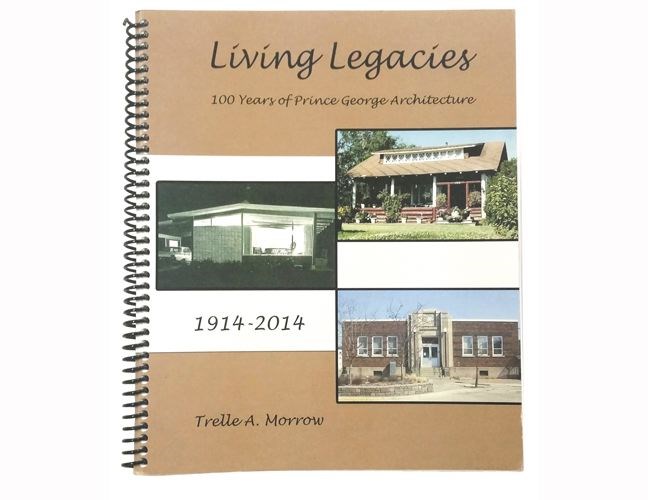There are few architects who live in Prince George anymore. Keeping watch over the construction of new buildings and neighbourhoods is the one who has served longest in those ranks and still calls this city home.
Trelle Morrow has become known as much as a local historian as for the many buildings he designed (including many schools, part of The Citizen building, the Roll-A-Dome when it was the city's first covered curling rink, and perhaps most famously Sacred Heart Cathedral). He has written books about the city's copious beehive burners, famous pack-train operator Cateline, the aviation industry's past, and many more.
For the first time, however, he has applied his ink to that which he knows best: architecture.
Morrow's latest tome is entitled Living Legacies: 100 Years of Prince George Architecture. It looks at the emblematic home, commercial, institutional and industrial edifices from 1914 when the first rail link was connected to the city and 2014 when the city stood on the cusp of the century-mark.
"It was a centennial project for me. I had so much information stored up in so many places, I felt I should dig it out and arrange it somehow," he said with a laugh about finally getting around to his own bailiwick.
"The biggest influence on what we did in Prince George was the modern period," said Morrow, referring to the movement that showed early signs at the turn of the 20th century, still has some influence on new buildings, but had its biggest impact from the 1920s to the 1960s with creep on either side when, said Morrow, "we got into the postmodernism movement. I talk about this a little bit in the Prince George context, but there isn't a lot documented on this subject for the whole province, and modernism was happening all over Canada."
There are pros and cons to modernism, and also to postmodernism. Critics have called the former style boring and jarring to the eye for all its straight lines and symmetry contrary to nature's curves and arcs.
Critics of the latter have pointed out its overemphasis on the facade to the detriment of the other sides of the building. Morrow points to the prime, local examples: the new Prince George RCMP detachment and the Two Rivers Gallery. Yes, both are spectacular on the face, but walk around the perimeter and watch the effect turn to bland, disjointed and architecturally unrelated sides.
"They are donkeys in behind, and racehorses up front," he said.
The common denominator, said Morrow, is local architecture has generally followed patterns. It was never a cacophony of random buildings. He parcels these themes into categories in his book.
"It's not up to me to say any of these things is right or wrong. It is for me to ask the question, 'Is this right for you? Is this what you want for the expressions your buildings make?'" he said.
Individual buildings adhered to architectural philosophies in a general sense, but individually there was a hodgepodge lack of cohesion. "But nevertheless, some good stuff came out of it," he said. "The Moffat house was not just a log cabin, it was based on Frank Lloyd Wright's prairie-style of design. Jock Munro built it and the Moffats bought it four or five years later.
"An awful lot of homes were built on designs clipped out of magazines, which is why in the Crescents area there are so many buildings close to one another but with dissimilar looks. The magazines of that day had floorplans included in them, and people wanted to have something all their own, so the owner would take a floorplan to a local a builder and get it built to suit."
With so many mills in the immediate area, it was easy for prospective homeowners to buy a cheap empty lot and have the necessary lumber easily accessible.
The Nechako Subdivision of 1958 was notable for the CMHC financial aid that spurred local development. The Seymour Subdivision of about 1960 was notable because CMHC was not involved - it was an initiative of the municipal government to raise money for city hall and ease the housing pressures of the day.
"Chapter 4 is my analysis of the housing crisis," Morrow said. "It was serious. Because of all the soldiers here during the Second World War and right afterwards, there were more people than homes to fit them in from 1942 to 1957."
The Fichtner Apartment Building is not especially interesting from an architectural point of view, he said, but it was the first multi-unit dwelling ever constructed in Prince George. It was a 1951 gesture to ease the overloaded need for rental spaces.
Although he strongly advocates for sensible heritage preservation, not just old for old's sake, he does lament that "Prince George has done a lot to destroy its own heritage. I use a picture of the old Alexander Hotel in the book, as an example, because that was torn down in 1957 for nothing more than a brick box, the Kresge department store building that is a furniture store now."
He focuses on seven distinct time periods in his examination of the city's architectural history.



